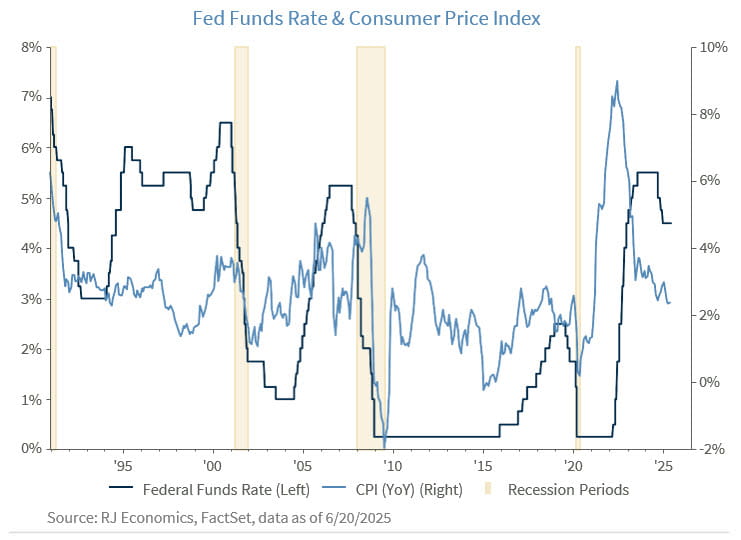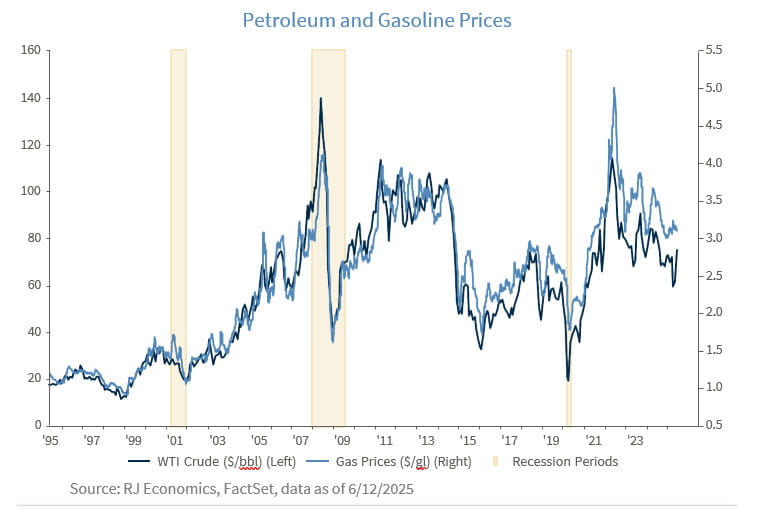A concerning press conference from the Fed Chairman
- 06.20.25
- Economy & Policy
- Commentary
Chief Economist Eugenio J. Alemán discusses current economic conditions.
We have seen a lack of conviction from the Federal Reserve (Fed) in previous opportunities (see our Weekly from March 22, 2024). Last year, during the first quarter, Fed members were spooked, as inflation numbers moved higher, changing their view on the path forward regarding interest rates.
This time around, it was just the opposite. Inflation figures during the first two quarters of the year were much better than expected, with the disinflationary process continuing. However, Fed officials kept their expected path for interest rates during this year unchanged from what it was in March. But what concerned us the most was, once again, the Fed Chairman’s lack of conviction not only on the path forward for interest rates but, more surprisingly, on the process the institution uses for determining the path forward for interest rates.
It is not that we do not understand the Chairman’s doubts about the future path for inflation and thus for interest rates, given the heightened levels of uncertainty created by the current administration’s trade and fiscal policies. But we are not the ones conducting monetary policy. He and his fellow Fed members are, so a little bit more conviction during the press conference regarding the process would be of great help.
It is clear that Fed members want to keep their independence from the political process intact and want to continue to avoid any accusation of political influence. Any hint that politicians are influencing monetary policy in any way, shape, or form could have a deleterious effect on inflation expectations, and that could undermine their ability to continue to lower inflation. At the same time, it will put the Fed in a very difficult position, which could even include having to increase interest rates rather than decrease them.
Politicians should make no mistake, with history as a guide, a politically independent Fed will be willing to bring the US economy to its knees, i.e., recession, rather than allow inflation expectations to reset higher and/or to allow inflation expectations to become unanchored.
Now, another event is supercharging concerns about the future path of inflation. If higher tariff concerns were not enough, the economy now has to deal with a potential escalation in Middle East tensions, with the added prospect that the US may get involved in the current fighting between Israel and Iran. Petroleum and gasoline prices have already taken notice, and this has certainly added to the Fed’s fears that inflation will be even more difficult to control going forward.
Furthermore, the administration’s comments about the Fed Chairman and the monetary policy process are not helping. And to add to the confusion, and barely two days into the Fed’s decision to keep interest rates unchanged, and adding more uncertainty during the press conference, Fed Governor Waller came out today saying that the Fed “could cut rates as early as July.”
We understand that many out there, including politicians, do not think that inflation expectations are something real. We disagree. While ‘real’ data is very important for inflation, individuals’ and firms’ beliefs about future prices could make or break inflation’s future path. And what we are seeing and hearing today, both from Fed officials as well as from politicians, is adding more fuel to the fire.
Economic and market conditions are subject to change.
Opinions are those of Investment Strategy and not necessarily those of Raymond James and are subject to change without notice. The information has been obtained from sources considered to be reliable, but we do not guarantee that the foregoing material is accurate or complete. There is no assurance any of the trends mentioned will continue or forecasts will occur. Past performance may not be indicative of future results.
Consumer Price Index is a measure of inflation compiled by the US Bureau of Labor Statistics. Currencies investing is generally considered speculative because of the significant potential for investment loss. Their markets are likely to be volatile and there may be sharp price fluctuations even during periods when prices overall are rising.
Consumer Sentiment is a consumer confidence index published monthly by the University of Michigan. The index is normalized to have a value of 100 in the first quarter of 1966. Each month at least 500 telephone interviews are conducted of a contiguous United States sample.
Personal Consumption Expenditures Price Index (PCE): The PCE is a measure of the prices that people living in the United States, or those buying on their behalf, pay for goods and services. The change in the PCE price index is known for capturing inflation (or deflation) across a wide range of consumer expenses and reflecting changes in consumer behavior.
The Consumer Confidence Index (CCI) is a survey, administered by The Conference Board, that measures how optimistic or pessimistic consumers are regarding their expected financial situation. A value above 100 signals a boost in the consumers’ confidence towards the future economic situation, as a consequence of which they are less prone to save, and more inclined to consume. The opposite applies to values under 100.
Certified Financial Planner Board of Standards Center for Financial Planning, Inc. owns and licenses the certification marks CFP®, CERTIFIED FINANCIAL PLANNER®, and CFP® (with plaque design) in the United States to Certified Financial Planner Board of Standards, Inc., which authorizes individuals who successfully complete the organization’s initial and ongoing certification requirements to use the certification marks.
Links are being provided for information purposes only. Raymond James is not affiliated with and does not endorse, authorize or sponsor any of the listed websites or their respective sponsors. Raymond James is not responsible for the content of any website or the collection or use of information regarding any website's users and/or members.
GDP Price Index: A measure of inflation in the prices of goods and services produced in the United States. The gross domestic product price index includes the prices of U.S. goods and services exported to other countries. The prices that Americans pay for imports aren't part of this index.
Employment cost Index: The Employment Cost Index (ECI) measures the change in the hourly labor cost to employers over time. The ECI uses a fixed “basket” of labor to produce a pure cost change, free from the effects of workers moving between occupations and industries and includes both the cost of wages and salaries and the cost of benefits.
US Dollar Index: The US Dollar Index is an index of the value of the United States dollar relative to a basket of foreign currencies, often referred to as a basket of U.S. trade partners' currencies. The Index goes up when the
U.S. dollar gains "strength" when compared to other currencies.
Import Price Index: The import price index measure price changes in goods or services purchased from abroad by U.S. residents (imports) and sold to foreign buyers (exports). The indexes are updated once a month by the Bureau of Labor Statistics (BLS) International Price Program (IPP).
ISM Services PMI Index: The Institute of Supply Management (ISM) Non-Manufacturing Purchasing Managers' Index (PMI) (also known as the ISM Services PMI) report on Business, a composite index is calculated as an indicator of the overall economic condition for the non-manufacturing sector.
Consumer Price Index (CPI) A consumer price index is a price index, the price of a weighted average market basket of consumer goods and services purchased by households.
Producer Price Index: A producer price index(PPI) is a price index that measures the average changes in prices received by domestic producers for their output.
Industrial production: Industrial production is a measure of output of the industrial sector of the economy. The industrial sector includes manufacturing, mining, and utilities. Although these sectors contribute only a small portion of gross domestic product, they are highly sensitive to interest rates and consumer demand.
The NAHB/Wells Fargo Housing Opportunity Index (HOI) for a given area is defined as the share of homes sold in that area that would have been affordable to a family earning the local median income, based on standard mortgage underwriting criteria.
Conference Board Coincident Economic Index: The Composite Index of Coincident Indicators is an index published by the Conference Board that provides a broad-based measurement of current economic conditions, helping economists, investors, and public policymakers to determine which phase of the business cycle the economy is currently experiencing.
Conference Board Lagging Economic Index: The Composite Index of Lagging Indicators is an index published monthly by the Conference Board, used to confirm and assess the direction of the economy's movements over recent months.
New Export Index: The PMI New export orders index allows us to track international demand for a country's goods and services on a timely, monthly, basis.
Gold is subject to the special risks associated with investing in precious metals, including but not limited to: price may be subject to wide fluctuation; the market is relatively limited; the sources are concentrated in countries that have the potential for instability; and the market is unregulated.
The Conference Board Leading Economic Index: Intended to forecast future economic activity, it is calculated from the values of ten key variables.
Source: FactSet, data as of 12/6/2024




